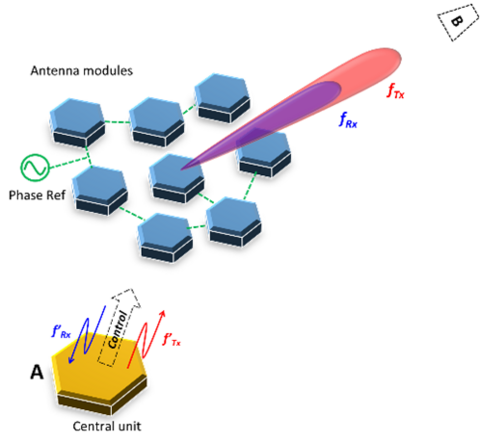Background
In order to enable higher data rates to a larger number of users, adaptive antennas are being used in various wireless communication systems. Such antennas constantly re-shape their radiation pattern to suppress the negative effects of the wireless channel impairments (interference and angular spread) which in turn will lead to a higher data throughput.
For a two-way wireless communication, the antenna array should provide a similar radiation pattern/direction for both the transmit (Tx) and receive (Rx) signals. At the reception side, the received signal can be used as a feedback to steer the Rx beam toward its optimal direction. For transmission however, there is no such feedback and thus conventional solutions to guide Tx beam rely on estimating the direction of arrival of the incoming signal or using retro-directive antenna arrays. The former requires a complex array calibration system and the latter cannot operate when Tx and Rx frequencies are different.
Description of the invention
The University of Waterloo has developed a novel retro-directive phased array antenna architecture. Thanks to its specific hardware design and circuitry, the Tx and Rx radiation beams are always aligned (locked) to each other and point toward the desired direction.
Advantages
In contrary to the conventional solutions, the UW developed antenna does not require characterization or calibration and thus can easily handle imperfections in its electronic components and circuitries. Furthermore, it can operate at arbitrary different Tx and Rx frequencies and independent of the modulation scheme. The array does not contain any moving parts thus its response to beam direction change is fast and smooth. The antenna is comprised of identical modules which can be built very low profile and distributed over an arbitrarily-shaped surface thus enabling new footprint implementation possibilities.
Potential applications
- Ubiquitous satellite internet access for mobile or fixed platforms such as airplanes, or remote areas.
- Indoor millimeter-wave wireless communication
- 5G systems communications

Retro-directive phased array antenna being used to establish a wireless link between node A and B
Reference
7420
Patent status
Patent issued
Stage of development
Working Prototype
Ongoing research
Contact
Scott Inwood
Director of Commercialization
Waterloo Commercialization Office
sinwood@uwaterloo.ca
uwaterloo.ca/research